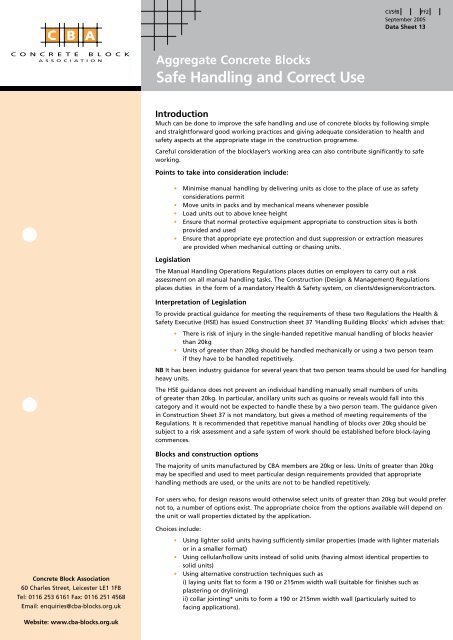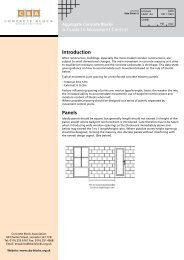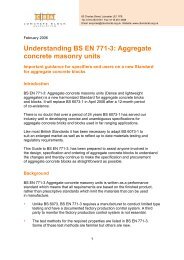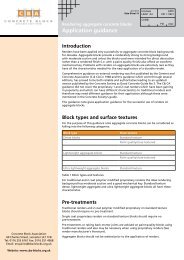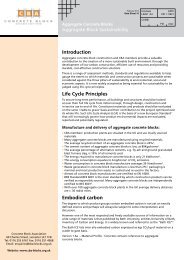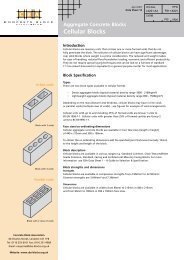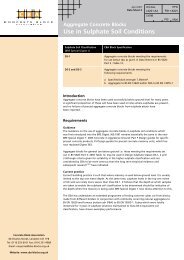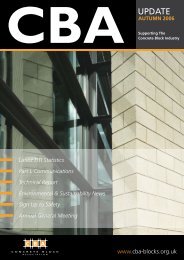Safe Handling and Correct Use - Concrete Block Association
Safe Handling and Correct Use - Concrete Block Association
Safe Handling and Correct Use - Concrete Block Association
You also want an ePaper? Increase the reach of your titles
YUMPU automatically turns print PDFs into web optimized ePapers that Google loves.
Cl/SfB Ff2September 2005Data Sheet 13Aggregate <strong>Concrete</strong> <strong>Block</strong>s<strong>Safe</strong> <strong>H<strong>and</strong>ling</strong> <strong>and</strong> <strong>Correct</strong> <strong>Use</strong>IntroductionMuch can be done to improve the safe h<strong>and</strong>ling <strong>and</strong> use of concrete blocks by following simple<strong>and</strong> straightforward good working practices <strong>and</strong> giving adequate consideration to health <strong>and</strong>safety aspects at the appropriate stage in the construction programme.Careful consideration of the blocklayer’s working area can also contribute significantly to safeworking.Points to take into consideration include:• Minimise manual h<strong>and</strong>ling by delivering units as close to the place of use as safetyconsiderations permit• Move units in packs <strong>and</strong> by mechanical means whenever possible• Load units out to above knee height• Ensure that normal protective equipment appropriate to construction sites is bothprovided <strong>and</strong> used• Ensure that appropriate eye protection <strong>and</strong> dust suppression or extraction measuresare provided when mechanical cutting or chasing units.LegislationThe Manual <strong>H<strong>and</strong>ling</strong> Operations Regulations places duties on employers to carry out a riskassessment on all manual h<strong>and</strong>ling tasks. The Construction (Design & Management) Regulationsplaces duties in the form of a m<strong>and</strong>atory Health & <strong>Safe</strong>ty system, on clients/designers/contractors.Interpretation of LegislationTo provide practical guidance for meeting the requirements of these two Regulations the Health &<strong>Safe</strong>ty Executive (HSE) has issued Construction sheet 37 ‘<strong>H<strong>and</strong>ling</strong> Building <strong>Block</strong>s' which advises that:• There is risk of injury in the single-h<strong>and</strong>ed repetitive manual h<strong>and</strong>ling of blocks heavierthan 20kg• Units of greater than 20kg should be h<strong>and</strong>led mechanically or using a two person teamif they have to be h<strong>and</strong>led repetitively.NB It has been industry guidance for several years that two person teams should be used for h<strong>and</strong>lingheavy units.The HSE guidance does not prevent an individual h<strong>and</strong>ling manually small numbers of unitsof greater than 20kg. In particular, ancillary units such as quoins or reveals would fall into thiscategory <strong>and</strong> it would not be expected to h<strong>and</strong>le these by a two person team. The guidance givenin Construction Sheet 37 is not m<strong>and</strong>atory, but gives a method of meeting requirements of theRegulations. It is recommended that repetitive manual h<strong>and</strong>ling of blocks over 20kg should besubject to a risk assessment <strong>and</strong> a safe system of work should be established before block-layingcommences.<strong>Block</strong>s <strong>and</strong> construction optionsThe majority of units manufactured by CBA members are 20kg or less. Units of greater than 20kgmay be specified <strong>and</strong> used to meet particular design requirements provided that appropriateh<strong>and</strong>ling methods are used, or the units are not to be h<strong>and</strong>led repetitively.For users who, for design reasons would otherwise select units of greater than 20kg but would prefernot to, a number of options exist. The appropriate choice from the options available will depend onthe unit or wall properties dictated by the application.Choices include:<strong>Concrete</strong> <strong>Block</strong> <strong>Association</strong>60 Charles Street, Leicester LE1 1FBTel: 0116 253 6161 Fax: 0116 251 4568Email: enquiries@cba-blocks.org.uk• Using lighter solid units having sufficiently similar properties (made with lighter materialsor in a smaller format)• Using cellular/hollow units instead of solid units (having almost identical properties tosolid units)• Using alternative construction techniques such asi) laying units flat to form a 190 or 215mm width wall (suitable for finishes such asplastering or drylining)ii) collar jointing* units to form a 190 or 215mm width wall (particularly suited tofacing applications).Website: www.cba-blocks.org.uk
Aggregate <strong>Concrete</strong> <strong>Block</strong>s<strong>Safe</strong> <strong>H<strong>and</strong>ling</strong> <strong>and</strong> <strong>Correct</strong> <strong>Use</strong>Whenever making the choice of units it is essential to ensure that the desired performancecharacteristics of the finished wall are not compromised. Your supplier will be able to adviseon an appropriate choice from the options available.*Collar jointing is laying units back to back in normal aspect with a 10-15mm cavity betweenthe adjoining faces of the units. The cavity should not be filled with mortar. The two leavesmay be tied together. If tied either normal ties or bed joint reinforcement may be used.Collar jointed walls are not suitable for separating walls in dwellings.Alternatives to full width solid units of greater than 20kgFor product specific data it is recommended that CBA member companies are consulted.Required wall thickness140mm190mm215mm<strong>Block</strong> Options140mm cellular of hollow(25-50% lighter than solid)140mm solid units having asmaller face size190mm cellular or hollow(25-50% lighter than solid)215mm cellular or hollow(25-50% lighter than solid)Construction Optionsi) 2 x 90mm leaves of solidunits collar jointedii) 390 x 190 x 100mm solidunits laid flati) 2 x 100mm leaves of solidunits collar jointedii) 440 x 215 x 100mm solidunits laid flatGuidance for Designers (based on test data <strong>and</strong> BS 5628: Pt 1)TABLE 1 Using a designation (i) mortar.(440 x 215mm face size units unless otherwise specified)f k values (characteristic wall compressive strength)for solid, cellular <strong>and</strong> hollow unitsUnit Strength (N/mm 2 )2.8 3.5 7 10 15140mm Solid 2.3 2.9 5.7 7.4 10.0140mm Cellular/Hollow 2.3 2.9 4.9 5.5 6.5190mm Solid 1.9 2.4 4.7 6.1 8.3190mm Cellular/Hollow 1.9 2.4 4.3 5.0 6.3215mm Solid 1.8 2.2 4.4 5.7 7.7215mm Cellular/Hollow 1.8 2.2 4.1 4.9 6.2f k values (characteristic wall compressive strength)for collar jointed wallsUnit Strength (N/mm 2 )2.8 3.5 7 10 15 20 35190mm wall 1.9 2.4 4.7 6.1 8.3 10.2 15.7215mm wall 1.8 2.2 4.4 5.7 7.7 9.5 14.7f k values (characteristic wall compressive strength)for units laid flatUnit Strength (N/mm 2 )2.8 3.5 7 10 15 20 35190mm wall* 2.2 2.7 5.3 5.9 8.1 10.0 15.4215mm wall 2.2 2.8 5.4 6.2 8.4 10.4 16.0*390 x 190 x 100mm blocksTABLE 2 Using a designation (iii) mortar.(440 x 215mm face size units unless otherwise specified)f k values (characteristic wall compressive strength)for solid, cellular <strong>and</strong> hollow unitsUnit Strength (N/mm 2 )2.8 3.5 7 10 15140mm Solid 2.3 2.9 5.4 6.9 8.4140mm Cellular/Hollow 2.3 2.9 4.7 5.0 5.5190mm Solid 1.9 2.4 4.4 5.7 6.9190mm Cellular/Hollow 1.9 2.4 4.0 4.6 5.3215mm Solid 1.8 2.2 4.1 5.3 6.4215mm Cellular/Hollow 1.8 2.2 3.8 4.5 5.2f k values (characteristic wall compressive strength)for collar jointed wallsUnit Strength (N/mm 2 )2.8 3.5 7 10 15 20 35190mm wall 1.9 2.4 4.4 5.7 6.9 8.0 11.7215mm wall 1.8 2.2 4.1 5.3 6.4 7.5 10.9f k values (characteristic wall compressive strength)for units laid flatUnit Strength (N/mm 2 )2.8 3.5 7 10 15 20 35190mm wall* 2.2 2.7 4.9 5.5 6.8 7.8 11.5215mm wall 2.2 2.8 5.1 5.7 7.0 8.1 11.9*390 x 190 x 100mm blocksNote:Depending upon material density some units in this table may exceed 20kg.Please check unit weight with block producer.To receive other data sheets in this series, a list of CBA members orfor further information, please contact <strong>Concrete</strong> <strong>Block</strong> <strong>Association</strong>.© The <strong>Concrete</strong> <strong>Block</strong> <strong>Association</strong> 2005Although The <strong>Concrete</strong> <strong>Block</strong> <strong>Association</strong> does its best to ensure thatany advice, recommendation or information it may give is accurate, noliability or responsibility of any kind (including liability for negligence)is accepted in this respect by the <strong>Association</strong>, its servants or agents.


